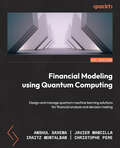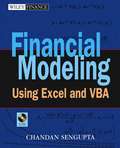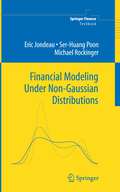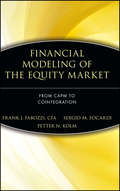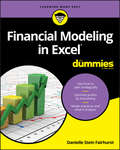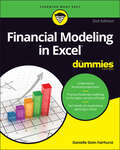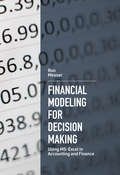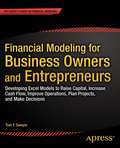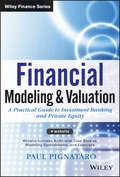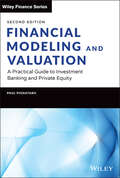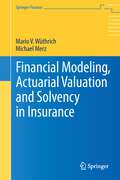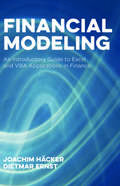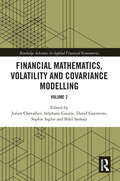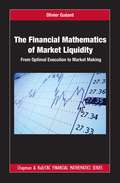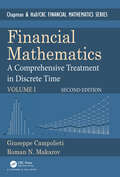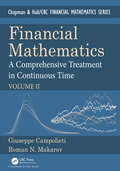- Table View
- List View
Financial Modeling Using Quantum Computing: A Complete Guide On How To Design And Manage Quantum Computing Solutions In Financial Analysis
by Anshul Saxena Javier Mancilla Shadab Hussain Iraitz MontalbanFinancial Modeling Using Excel and VBA (Wiley Finance #152)
by Chandan SenguptaComprehensive instruction on developing real-world financial models This book, designed for self-study, classroom use, and reference, presents a com-prehensive approach to developing simple to sophisticated financial models in all major areas of finance. The approach is based on the author's 20 years of experience of developing such models in the business world and teaching a popular MBA class in financial modeling. The book assumes only basic knowledge of Excel and teaches all advanced features of Excel and VBA from scratch using a unique simple method. A companion CD includes all working versions of all the models presented in the book and additional useful reference material. Chandan Sengupta (White Plains, NY) teaches finance in the MBA program at Fordham University's Graduate School of Business. Formerly, he was vice president of the Chase Manhattan Bank for eight years and senior financial advisor for Mobil Corporation for 10 years. He is also the author of The Only Proven Road to Investment Success (0-471-44307-7).
Financial Modeling Under Non-Gaussian Distributions (Springer Finance)
by Eric Jondeau Ser-Huang Poon Michael RockingerThis book examines non-Gaussian distributions. It addresses the causes and consequences of non-normality and time dependency in both asset returns and option prices. The book is written for non-mathematicians who want to model financial market prices so the emphasis throughout is on practice. There are abundant empirical illustrations of the models and techniques described, many of which could be equally applied to other financial time series.
Financial Modeling of the Equity Market: From CAPM to Cointegration (Frank J. Fabozzi Series #146)
by Frank J. Fabozzi Sergio M. Focardi Petter N. KolmAn inside look at modern approaches to modeling equity portfolios Financial Modeling of the Equity Market is the most comprehensive, up-to-date guide to modeling equity portfolios. The book is intended for a wide range of quantitative analysts, practitioners, and students of finance. Without sacrificing mathematical rigor, it presents arguments in a concise and clear style with a wealth of real-world examples and practical simulations. This book presents all the major approaches to single-period return analysis, including modeling, estimation, and optimization issues. It covers both static and dynamic factor analysis, regime shifts, long-run modeling, and cointegration. Estimation issues, including dimensionality reduction, Bayesian estimates, the Black-Litterman model, and random coefficient models, are also covered in depth. Important advances in transaction cost measurement and modeling, robust optimization, and recent developments in optimization with higher moments are also discussed. Sergio M. Focardi (Paris, France) is a founding partner of the Paris-based consulting firm, The Intertek Group. He is a member of the editorial board of the Journal of Portfolio Management. He is also the author of numerous articles and books on financial modeling. Petter N. Kolm, PhD (New Haven, CT and New York, NY), is a graduate student in finance at the Yale School of Management and a financial consultant in New York City. Previously, he worked in the Quantitative Strategies Group of Goldman Sachs Asset Management, where he developed quantitative investment models and strategies.
Financial Modeling in Excel For Dummies
by Danielle Stein FairhurstMake informed business decisions with the beginner's guide to financial modeling using Microsoft Excel Financial Modeling in Excel For Dummies is your comprehensive guide to learning how to create informative, enlightening financial models today. Not a math whiz or an Excel power-user? No problem! All you need is a basic understanding of Excel to start building simple models with practical hands-on exercises and before you know it, you'll be modeling your way to optimized profits for your business in no time. Excel is powerful, user-friendly, and is most likely already installed on your computer—which is why it has so readily become the most popular financial modeling software. This book shows you how to harness Excel's capabilities to determine profitability, develop budgetary projections, model depreciation, project costs, value assets and more. You'll learn the fundamental best practices and know-how of financial modeling, and how to put them to work for your business and your clients. You'll learn the tools and techniques that bring insight out of the numbers, and make better business decisions based on quantitative evidence. You'll discover that financial modeling is an invaluable resource for your business, and you'll wonder why you've waited this long to learn how! Companies around the world use financial modeling for decision making, to steer strategy, and to develop solutions. This book walks you through the process with clear, expert guidance that assumes little prior knowledge. Learn the six crucial rules to follow when building a successful financial model Discover how to review and edit an inherited financial model and align it with your business and financial strategy Solve client problems, identify market projections, and develop business strategies based on scenario analysis Create valuable customized templates models that can become a source of competitive advantage From multinational corporations to the mom-and-pop corner store, there isn't a business around that wouldn't benefit from financial modeling. No need to buy expensive specialized software—the tools you need are right there in Excel. Financial Modeling in Excel For Dummies gets you up to speed quickly so you can start reaping the benefits today!
Financial Modeling in Excel For Dummies
by Danielle Stein FairhurstMake informed business decisions with the beginner's guide to financial modeling using Microsoft Excel Financial Modeling in Excel For Dummies is your comprehensive guide to learning how to create informative, enlightening financial models today. Not a math whiz or an Excel power-user? No problem! All you need is a basic understanding of Excel to start building simple models with practical hands-on exercises and before you know it, you'll be modeling your way to optimized profits for your business in no time. Excel is powerful, user-friendly, and is most likely already installed on your computer—which is why it has so readily become the most popular financial modeling software. This book shows you how to harness Excel's capabilities to determine profitability, develop budgetary projections, model depreciation, project costs, value assets and more. You'll learn the fundamental best practices and know-how of financial modeling, and how to put them to work for your business and your clients. You'll learn the tools and techniques that bring insight out of the numbers, and make better business decisions based on quantitative evidence. You'll discover that financial modeling is an invaluable resource for your business, and you'll wonder why you've waited this long to learn how! Companies around the world use financial modeling for decision making, to steer strategy, and to develop solutions. This book walks you through the process with clear, expert guidance that assumes little prior knowledge. Learn the six crucial rules to follow when building a successful financial model Discover how to review and edit an inherited financial model and align it with your business and financial strategy Solve client problems, identify market projections, and develop business strategies based on scenario analysis Create valuable customized templates models that can become a source of competitive advantage From multinational corporations to the mom-and-pop corner store, there isn't a business around that wouldn't benefit from financial modeling. No need to buy expensive specialized software—the tools you need are right there in Excel. Financial Modeling in Excel For Dummies gets you up to speed quickly so you can start reaping the benefits today!
Financial Modeling in Excel For Dummies
by Danielle Stein FairhurstTurn your financial data into insightful decisions with this straightforward guide to financial modeling with Excel Interested in learning how to build practical financial models and forecasts but concerned that you don’t have the math skills or technical know-how? We’ve got you covered! Financial decision-making has never been easier than with Financial Modeling in Excel For Dummies. Whether you work at a mom-and-pop retail store or a multinational corporation, you can learn how to build budgets, project your profits into the future, model capital depreciation, value your assets, and more. You’ll learn by doing as this book walks you through practical, hands-on exercises to help you build powerful models using just a regular version of Excel, which you’ve probably already got on your PC. You’ll also: Master the tools and strategies that help you draw insights from numbers and data you’ve already got Build a successful financial model from scratch, or work with and modify an existing one to your liking Create new and unexpected business strategies with the ideas and conclusions you generate with scenario analysis Don’t go buying specialized software or hiring that expensive consultant when you don’t need either one. If you’ve got this book and a working version of Microsoft Excel, you’ve got all the tools you need to build sophisticated and useful financial models in no time!
Financial Modeling in Excel For Dummies
by Danielle Stein FairhurstTurn your financial data into insightful decisions with this straightforward guide to financial modeling with Excel Interested in learning how to build practical financial models and forecasts but concerned that you don’t have the math skills or technical know-how? We’ve got you covered! Financial decision-making has never been easier than with Financial Modeling in Excel For Dummies. Whether you work at a mom-and-pop retail store or a multinational corporation, you can learn how to build budgets, project your profits into the future, model capital depreciation, value your assets, and more. You’ll learn by doing as this book walks you through practical, hands-on exercises to help you build powerful models using just a regular version of Excel, which you’ve probably already got on your PC. You’ll also: Master the tools and strategies that help you draw insights from numbers and data you’ve already got Build a successful financial model from scratch, or work with and modify an existing one to your liking Create new and unexpected business strategies with the ideas and conclusions you generate with scenario analysis Don’t go buying specialized software or hiring that expensive consultant when you don’t need either one. If you’ve got this book and a working version of Microsoft Excel, you’ve got all the tools you need to build sophisticated and useful financial models in no time!
Financial Modeling for Decision Making: Using MS-Excel in Accounting and Finance
by Ron MesserMost books on Microsoft Excel for accounting and finance serve primarily academic research purposes: they are relatively unstructured and dominated by discussions of rather esoteric and infrequently used applications. None addresses the growing need for an introduction to crucial data analytic skills (i.e., analysis of ‘big data’) and to the recent innovations by Microsoft Excel in this regard, including Power Query (data cleaning and management), Power Pivot (advanced pivot tables using databases) and Power BI (creating executive KPI dashboards). In Financial Modeling for Decision Making: Using MS-Excel in Accounting and Finance, Ron Messer provides just such a practical, advanced-level guide to this essential program. Crucially, he focuses on using Excel in situations encountered by accounting and finance students and professionals, and he structures these in terms of the past, present and future in order to reflect a typical operating cycle, which includes initial planning, exercising control, and receiving feedback. Throughout this book, Messer discusses real-life applications of this important analytical tool, which has become the industry standard for spreadsheet software. For its clear structure and emphasis on practical usage, Financial Modeling for Decision Making is essential reading for accounting and finance professionals, as well as accounting and finance students in post-secondary institutions.
Financial Modeling for Decision Making: Using MS-Excel in Accounting and Finance
by Ron MesserMost books on Microsoft Excel for accounting and finance serve primarily academic research purposes: they are relatively unstructured and dominated by discussions of rather esoteric and infrequently used applications. None addresses the growing need for an introduction to crucial data analytic skills (i.e., analysis of ‘big data’) and to the recent innovations by Microsoft Excel in this regard, including Power Query (data cleaning and management), Power Pivot (advanced pivot tables using databases) and Power BI (creating executive KPI dashboards). In Financial Modeling for Decision Making: Using MS-Excel in Accounting and Finance, Ron Messer provides just such a practical, advanced-level guide to this essential program. Crucially, he focuses on using Excel in situations encountered by accounting and finance students and professionals, and he structures these in terms of the past, present and future in order to reflect a typical operating cycle, which includes initial planning, exercising control, and receiving feedback. Throughout this book, Messer discusses real-life applications of this important analytical tool, which has become the industry standard for spreadsheet software. For its clear structure and emphasis on practical usage, Financial Modeling for Decision Making is essential reading for accounting and finance professionals, as well as accounting and finance students in post-secondary institutions.
Financial Modeling for Business Owners and Entrepreneurs: Developing Excel Models to Raise Capital, Increase Cash Flow, Improve Operations, Plan Projects, and Make Decisions
by Tom Y. SawyerFinancial Modeling for Business Owners and Entrepreneurs: Developing Excel Models to Raise Capital, Increase Cash Flow, Improve Operations, Plan Projects, and Make Decisions may be one of the most important books any entrepreneur or manager in a small or medium-sized enterprise will read. It combines logical business principles and strategies with a step-by-step methodology for planning and modeling a company and solving specific business problems. You’ll learn to create operational and financial models in Excel that describe the workings of your company in quantitative terms and that make it far more likely you will avoid the traps and dead ends many businesses fall into.Serial entrepreneur and financial expert Tom Y. Sawyer shows how to break your company down into basic functional and operational components that can be modeled. The result is a financial model that, for example, you can literally take to the bank or bring to local angel investors to receive the funding you need to launch your business or a new product. Or it might be a model that shows with startling clarity that your new product development effort is a likely winner—or loser. Even better, you’ll learn to create models that will serve as guideposts for ongoing operations. You’ll always know just where you are financially, and where you need to be. The models you will learn to build in Financial Modeling for Business Owners and Entrepreneurs can be used to:Raise capital for startup or any stage of growthPlan projects and new initiativesMake astute business decisions, including go/no-go assessmentsAnalyze ROI on your product development and marketing expendituresStreamline operations, manage budgets, improve efficiency, and reduce costsValue the business when it is time to cash out or mergeIn addition to many valuable exercises and tips for using Excel to model your business, this book contains a combination of practical advice born of hard-won lessons, advanced strategic thought, and the insightful use of hard skills. With a basic knowledge of Excel assumed, it will help you learn to think like an experienced business person who expects to make money on the products or services offered to the public. You’ll discover that the financial model is a key management tool that, if built correctly, provides invaluable assistance every step of the entrepreneurial journey.Tom Y. Sawyer has used the principles this book contains to create financial models of numerous startup and early-stage companies, assisting them in planning for and raising the capital that they needed to grow their businesses and ultimately exit with multiples of their initial investment. Financial Modeling for Business Owners and Entrepreneurs, a mini-MBA in entrepreneurship and finance, will show you how you can do the same.Note: This book is an updated version of Sawyer's 2009 title, Pro Excel Financial Modeling.
Financial Modeling and Valuation: A Practical Guide to Investment Banking and Private Equity (Wiley Finance #876)
by Paul PignataroWritten by the Founder and CEO of the prestigious New York School of Finance, this book schools you in the fundamental tools for accurately assessing the soundness of a stock investment. Built around a full-length case study of Wal-Mart, it shows you how to perform an in-depth analysis of that company's financial standing, walking you through all the steps of developing a sophisticated financial model as done by professional Wall Street analysts. You will construct a full scale financial model and valuation step-by-step as you page through the book. When we ran this analysis in January of 2012, we estimated the stock was undervalued. Since the first run of the analysis, the stock has increased 35 percent. Re-evaluating Wal-Mart 9months later, we will step through the techniques utilized by Wall Street analysts to build models on and properly value business entities. Step-by-step financial modeling - taught using downloadable Wall Street models, you will construct the model step by step as you page through the book. Hot keys and explicit Excel instructions aid even the novice excel modeler. Model built complete with Income Statement, Cash Flow Statement, Balance Sheet, Balance Sheet Balancing Techniques, Depreciation Schedule (complete with accelerating depreciation and deferring taxes), working capital schedule, debt schedule, handling circular references, and automatic debt pay downs. Illustrative concepts including detailing model flows help aid in conceptual understanding. Concepts are reiterated and honed, perfect for a novice yet detailed enough for a professional. Model built direct from Wal-Mart public filings, searching through notes, performing research, and illustrating techniques to formulate projections. Includes in-depth coverage of valuation techniques commonly used by Wall Street professionals. Illustrative comparable company analyses - built the right way, direct from historical financials, calculating LTM (Last Twelve Month) data, calendarization, and properly smoothing EBITDA and Net Income. Precedent transactions analysis - detailing how to extract proper metrics from relevant proxy statements Discounted cash flow analysis - simplifying and illustrating how a DCF is utilized, how unlevered free cash flow is derived, and the meaning of weighted average cost of capital (WACC) Step-by-step we will come up with a valuation on Wal-Mart Chapter end questions, practice models, additional case studies and common interview questions (found in the companion website) help solidify the techniques honed in the book; ideal for universities or business students looking to break into the investment banking field.
Financial Modeling and Valuation: A Practical Guide to Investment Banking and Private Equity (Wiley Finance)
by Paul PignataroWritten by the Founder and CEO of the prestigious New York School of Finance, this book schools you in the fundamental tools for accurately assessing the soundness of a stock investment. Built around a full-length case study of Wal-Mart, it shows you how to perform an in-depth analysis of that company's financial standing, walking you through all the steps of developing a sophisticated financial model as done by professional Wall Street analysts. You will construct a full scale financial model and valuation step-by-step as you page through the book. When we ran this analysis in January of 2012, we estimated the stock was undervalued. Since the first run of the analysis, the stock has increased 35 percent. Re-evaluating Wal-Mart 9months later, we will step through the techniques utilized by Wall Street analysts to build models on and properly value business entities. Step-by-step financial modeling - taught using downloadable Wall Street models, you will construct the model step by step as you page through the book. Hot keys and explicit Excel instructions aid even the novice excel modeler. Model built complete with Income Statement, Cash Flow Statement, Balance Sheet, Balance Sheet Balancing Techniques, Depreciation Schedule (complete with accelerating depreciation and deferring taxes), working capital schedule, debt schedule, handling circular references, and automatic debt pay downs. Illustrative concepts including detailing model flows help aid in conceptual understanding. Concepts are reiterated and honed, perfect for a novice yet detailed enough for a professional. Model built direct from Wal-Mart public filings, searching through notes, performing research, and illustrating techniques to formulate projections. Includes in-depth coverage of valuation techniques commonly used by Wall Street professionals. Illustrative comparable company analyses - built the right way, direct from historical financials, calculating LTM (Last Twelve Month) data, calendarization, and properly smoothing EBITDA and Net Income. Precedent transactions analysis - detailing how to extract proper metrics from relevant proxy statements Discounted cash flow analysis - simplifying and illustrating how a DCF is utilized, how unlevered free cash flow is derived, and the meaning of weighted average cost of capital (WACC) Step-by-step we will come up with a valuation on Wal-Mart Chapter end questions, practice models, additional case studies and common interview questions (found in the companion website) help solidify the techniques honed in the book; ideal for universities or business students looking to break into the investment banking field.
Financial Modeling and Valuation: A Practical Guide to Investment Banking and Private Equity (Wiley Finance)
by Paul PignataroThe fully revised new edition of the best-selling guide to using financial models to determine if a stock is over or undervalued Written by the founder and CEO of the world-renowned New York School of Finance, Financial Modeling and Valuation provides clear and systematic guidance on accurately evaluating the soundness of a stock investment. This invaluable handbook equips investors with the tools necessary for understanding the underlying fundamentals of a rational investment and for making smarter investment decisions in any market environment. Built around an in-depth case study of global retail leader Amazon, this fully updated Second Edition shows you how to analyze the financial standing of a company using the methods of Wall Street professionals. Step-by-step, you will learn to build the core three statements—income statement, cash flow statement, and balance sheet—as well as the three major supporting schedules required for complete company valuation and analysis. All line items are explained in clear language and include real-world tips and techniques for using them as tools for valuing and managing a business. This must-have guide: Features new and in-depth case studies based on Amazon that simulate real-world modelling and valuation Explains valuation techniques such as illustrative comparable company analysis, precedent transactions analysis, and discounted cash flow analysis Covers all essential applications of a model, including pricing a stock, raising debt, and raising equity Includes an introductory section describing the recent and dramatic shift of the entire retail industry Provides end-of-chapter questions, downloadable practice models, additional case studies, and common interview questions via a companion website Financial Modeling and Valuation: A Practical Guide to Investment Banking and Private Equity, Second Edition is essential reading for finance professionals, venture capitalists, individual investors, and students in investment banking and related degree programs in finance.
Financial Modeling and Valuation: A Practical Guide to Investment Banking and Private Equity (Wiley Finance)
by Paul PignataroThe fully revised new edition of the best-selling guide to using financial models to determine if a stock is over or undervalued Written by the founder and CEO of the world-renowned New York School of Finance, Financial Modeling and Valuation provides clear and systematic guidance on accurately evaluating the soundness of a stock investment. This invaluable handbook equips investors with the tools necessary for understanding the underlying fundamentals of a rational investment and for making smarter investment decisions in any market environment. Built around an in-depth case study of global retail leader Amazon, this fully updated Second Edition shows you how to analyze the financial standing of a company using the methods of Wall Street professionals. Step-by-step, you will learn to build the core three statements—income statement, cash flow statement, and balance sheet—as well as the three major supporting schedules required for complete company valuation and analysis. All line items are explained in clear language and include real-world tips and techniques for using them as tools for valuing and managing a business. This must-have guide: Features new and in-depth case studies based on Amazon that simulate real-world modelling and valuation Explains valuation techniques such as illustrative comparable company analysis, precedent transactions analysis, and discounted cash flow analysis Covers all essential applications of a model, including pricing a stock, raising debt, and raising equity Includes an introductory section describing the recent and dramatic shift of the entire retail industry Provides end-of-chapter questions, downloadable practice models, additional case studies, and common interview questions via a companion website Financial Modeling and Valuation: A Practical Guide to Investment Banking and Private Equity, Second Edition is essential reading for finance professionals, venture capitalists, individual investors, and students in investment banking and related degree programs in finance.
Financial Modeling, Actuarial Valuation and Solvency in Insurance (Springer Finance)
by Mario V. Wüthrich Michael MerzRisk management for financial institutions is one of the key topics the financial industry has to deal with. The present volume is a mathematically rigorous text on solvency modeling. Currently, there are many new developments in this area in the financial and insurance industry (Basel III and Solvency II), but none of these developments provides a fully consistent and comprehensive framework for the analysis of solvency questions. Merz and Wüthrich combine ideas from financial mathematics (no-arbitrage theory, equivalent martingale measure), actuarial sciences (insurance claims modeling, cash flow valuation) and economic theory (risk aversion, probability distortion) to provide a fully consistent framework. Within this framework they then study solvency questions in incomplete markets, analyze hedging risks, and study asset-and-liability management questions, as well as issues like the limited liability options, dividend to shareholder questions, the role of re-insurance, etc. This work embeds the solvency discussion (and long-term liabilities) into a scientific framework and is intended for researchers as well as practitioners in the financial and actuarial industry, especially those in charge of internal risk management systems. Readers should have a good background in probability theory and statistics, and should be familiar with popular distributions, stochastic processes, martingales, etc.
Financial Modeling: An Introductory Guide to Excel and VBA Applications in Finance (Global Financial Markets)
by Joachim Häcker Dietmar ErnstThis book provides a comprehensive introduction to modern financial modeling using Excel, VBA, standards of financial modeling and model review. It offers guidance on essential modeling concepts around the four core financial activities in the modern financial industry today: financial management; corporate finance; portfolio management and financial derivatives. Written in a highly practical, market focused manner, it gives step-by-step guidance on modeling practical problems in a structured manner. Quick and interactive learning is assured due to the structure as a training course which includes applied examples that are easy to follow. All applied examples contained in the book can be reproduced step by step with the help of the Excel files. The content of this book serves as the foundation for the training course Certified Financial Modeler.In an industry that is becoming increasingly complex, financial modeling is a key skill for practitioners across all key sectors of finance and banking, where complicated problems often need to be solved quickly and clearly. This book will equip readers with the basic modeling skills required across the industry today.
Financial Microeconometrics: A Research Methodology in Corporate Finance and Accounting
by Marek GruszczyńskiThis book explores new topics in modern research on empirical corporate finance and applied accounting, especially the econometric analysis of microdata. Dubbed “financial microeconometrics” by the author, this concept unites both methodological and applied approaches. The book examines how quantitative methods can be applied in corporate finance and accounting research in order to predict companies getting into financial distress. Presented in a clear and straightforward manner, it also suggests methods for linking corporate governance to financial performance, and discusses what the determinants of accounting disclosures are. Exploring these questions by way of numerous practical examples, this book is intended for researchers, practitioners and students who are not yet familiar with the variety of approaches available for data analysis and microeconometrics.“This book on financial microeconometrics is an excellent starting point for research in corporate finance and accounting. In my view, the text is positioned between a narrative and a scientific treatise. It is based on a vast amount of literature but is not overloaded with formulae. My appreciation of financial microeconometrics has very much increased. The book is well organized and properly written. I enjoyed reading it.” Wolfgang Marty, Senior Investment Strategist, AgaNola AG
Financial Mathematics, Volatility and Covariance Modelling: Volume 2 (Routledge Advances in Applied Financial Econometrics)
by Julien Chevallier Stéphane Goutte David Guerreiro Sophie Saglio Bilel SanhajiThis book provides an up-to-date series of advanced chapters on applied financial econometric techniques pertaining the various fields of commodities finance, mathematics & stochastics, international macroeconomics and financial econometrics. Financial Mathematics, Volatility and Covariance Modelling: Volume 2 provides a key repository on the current state of knowledge, the latest debates and recent literature on financial mathematics, volatility and covariance modelling. The first section is devoted to mathematical finance, stochastic modelling and control optimization. Chapters explore the recent financial crisis, the increase of uncertainty and volatility, and propose an alternative approach to deal with these issues. The second section covers financial volatility and covariance modelling and explores proposals for dealing with recent developments in financial econometrics This book will be useful to students and researchers in applied econometrics; academics and students seeking convenient access to an unfamiliar area. It will also be of great interest established researchers seeking a single repository on the current state of knowledge, current debates and relevant literature.
Financial Mathematics, Volatility and Covariance Modelling: Volume 2 (Routledge Advances in Applied Financial Econometrics)
by Julien Chevallier David Guerreiro Sophie Saglio Bilel Sanhaji Stephane GoutteThis book provides an up-to-date series of advanced chapters on applied financial econometric techniques pertaining the various fields of commodities finance, mathematics & stochastics, international macroeconomics and financial econometrics. Financial Mathematics, Volatility and Covariance Modelling: Volume 2 provides a key repository on the current state of knowledge, the latest debates and recent literature on financial mathematics, volatility and covariance modelling. The first section is devoted to mathematical finance, stochastic modelling and control optimization. Chapters explore the recent financial crisis, the increase of uncertainty and volatility, and propose an alternative approach to deal with these issues. The second section covers financial volatility and covariance modelling and explores proposals for dealing with recent developments in financial econometrics This book will be useful to students and researchers in applied econometrics; academics and students seeking convenient access to an unfamiliar area. It will also be of great interest established researchers seeking a single repository on the current state of knowledge, current debates and relevant literature.
The Financial Mathematics of Market Liquidity: From Optimal Execution to Market Making
by Olivier GueantThis book is among the first to present the mathematical models most commonly used to solve optimal execution problems and market making problems in finance. The Financial Mathematics of Market Liquidity: From Optimal Execution to Market Making presents a general modeling framework for optimal execution problems-inspired from the Almgren-Chriss app
Financial Mathematics, Derivatives and Structured Products
by Raymond H. Chan Spike T. Lee Xun Li Yves ZY. GuoThis book introduces readers to the financial markets, derivatives, structured products and how the products are modelled and implemented by practitioners. In addition, it equips readers with the necessary knowledge of financial markets needed in order to work as product structurers, traders, sales or risk managers. As the book seeks to unify the derivatives modelling and the financial engineering practice in the market, it will be of interest to financial practitioners and academic researchers alike. Further, it takes a different route from the existing financial mathematics books, and will appeal to students and practitioners with or without a scientific background. The book can also be used as a textbook for the following courses: • Financial Mathematics (undergraduate level) • Stochastic Modelling in Finance (postgraduate level) • Financial Markets and Derivatives (undergraduate level) • Structured Products and Solutions (undergraduate/postgraduate level)
Financial Mathematics: Lectures given at the 3rd Session of the Centro Internazionale Matematico Estivo (C.I.M.E.) held in Bressanone, Italy, July 8-13, 1996 (Lecture Notes in Mathematics #1656)
by Bruno Biais Thomas Björk Jakša Cvitanic Nicole El Karoui Elyes Jouini J.C. RochetFinancial Mathematics is an exciting, emerging field of application. The five sets of course notes in this book provide a bird's eye view of the current "state of the art" and directions of research. For graduate students it will therefore serve as an introduction to the field while reseachers will find it a compact source of reference. The reader is expected to have a good knowledge of the basic mathematical tools corresponding to an introductory graduate level and sufficient familiarity with probabilistic methods, in particular stochastic analysis.
Financial Mathematics: A Comprehensive Treatment in Discrete Time (Chapman and Hall/CRC Financial Mathematics Series)
by Giuseppe Campolieti Roman N. MakarovThe book has been tested and refined through years of classroom teaching experience. With an abundance of examples, problems, and fully worked out solutions, the text introduces the financial theory and relevant mathematical methods in a mathematically rigorous yet engaging way. This textbook provides complete coverage of discrete-time financial models that form the cornerstones of financial derivative pricing theory. Unlike similar texts in the field, this one presents multiple problem-solving approaches, linking related comprehensive techniques for pricing different types of financial derivatives. Key features: In-depth coverage of discrete-time theory and methodology. Numerous, fully worked out examples and exercises in every chapter. Mathematically rigorous and consistent yet bridging various basic and more advanced concepts. Judicious balance of financial theory, mathematical, and computational methods. Guide to Material. This revision contains: Almost 200 pages worth of new material in all chapters. A new chapter on elementary probability theory. An expanded the set of solved problems and additional exercises. Answers to all exercises. This book is a comprehensive, self-contained, and unified treatment of the main theory and application of mathematical methods behind modern-day financial mathematics.
Financial Mathematics: A Comprehensive Treatment in Continuous Time Volume II (Textbooks in Mathematics)
by Giuseppe Campolieti Roman N. MakarovThe book has been tested and refined through years of classroom teaching experience. With an abundance of examples, problems, and fully worked out solutions, the text introduces the financial theory and relevant mathematical methods in a mathematically rigorous yet engaging way. This textbook provides complete coverage of continuous-time financial models that form the cornerstones of financial derivative pricing theory. Unlike similar texts in the field, this one presents multiple problem-solving approaches, linking related comprehensive techniques for pricing different types of financial derivatives. Key features: In-depth coverage of continuous-time theory and methodology Numerous, fully worked out examples and exercises in every chapter Mathematically rigorous and consistent, yet bridging various basic and more advanced concepts Judicious balance of financial theory and mathematical methods Guide to Material This revision contains: Almost 150 pages worth of new material in all chapters A appendix on probability theory An expanded set of solved problems and additional exercises Answers to all exercises This book is a comprehensive, self-contained, and unified treatment of the main theory and application of mathematical methods behind modern-day financial mathematics. The text complements Financial Mathematics: A Comprehensive Treatment in Discrete Time, by the same authors, also published by CRC Press.
